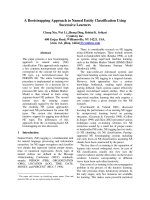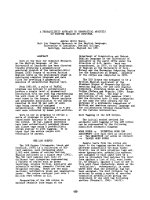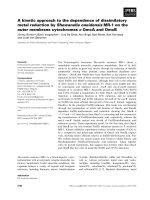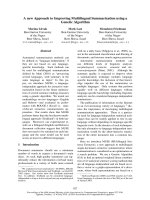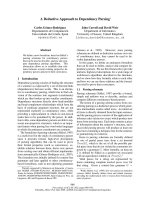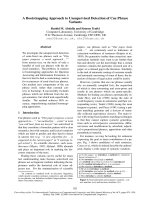Báo cáo khoa học: "A Two-step Approach to Sentence Compression of Spoken Utterances" pdf
Bạn đang xem bản rút gọn của tài liệu. Xem và tải ngay bản đầy đủ của tài liệu tại đây (141.26 KB, 5 trang )
Proceedings of the 50th Annual Meeting of the Association for Computational Linguistics, pages 166–170,
Jeju, Republic of Korea, 8-14 July 2012.
c
2012 Association for Computational Linguistics
A Two-step Approach to Sentence Compression of Spoken Utterances
Dong Wang, Xian Qian, Yang Liu
The University of Texas at Dallas
dongwang,qx,
Abstract
This paper presents a two-step approach to
compress spontaneous spoken utterances. In
the first step, we use a sequence labeling
method to determine if a word in the utterance
can be removed, and generate n-best com-
pressed sentences. In the second step, we
use a discriminative training approach to cap-
ture sentence level global information from
the candidates and rerank them. For evalua-
tion, we compare our system output with mul-
tiple human references. Our results show that
the new features we introduced in the first
compression step improve performance upon
the previous work on the same data set, and
reranking is able to yield additional gain, espe-
cially when training is performed to take into
account multiple references.
1 Introduction
Sentence compression aims to preserve the most im-
portant information in the original sentence with
fewer words. It can be used for abstractive summa-
rization where extracted important sentences often
need to be compressed and merged. For summariza-
tion of spontaneous speech, sentence compression
is especially important, since unlike fluent and well-
structured written text, spontaneous speech contains
a lot of disfluencies and much redundancy. The fol-
lowing shows an example of a pair of source and
compressed spoken sentences
1
from human annota-
tion (removed words shown in bold):
[original sentence]
1
For speech domains, “sentences” are not clearly defined.
We use sentences and utterances interchangeably when there is
no ambiguity.
and then um in terms of the source the things uh the
only things that we had on there I believe were whether
[compressed sentence]
and then in terms of the source the only things that we
had on there were whether
In this study we investigate sentence compres-
sion of spoken utterances in order to remove re-
dundant or unnecessary words while trying to pre-
serve the information in the original sentence. Sen-
tence compression has been studied from formal
text domain to speech domain. In text domain,
(Knight and Marcu, 2000) applies noisy-channel
model and decision tree approaches on this prob-
lem. (Galley and Mckeown, 2007) proposes to use a
synchronous context-free grammars (SCFG) based
method to compress the sentence. (Cohn and La-
pata, 2008) expands the operation set by including
insertion, substitution and reordering, and incorpo-
rates grammar rules. In speech domain, (Clarke and
Lapata, 2008) investigates sentence compression in
broadcast news using an integer linear programming
approach. There is only a few existing work in spon-
taneous speech domains. (Liu and Liu, 2010) mod-
eled it as a sequence labeling problem using con-
ditional random fields model. (Liu and Liu, 2009)
compared the effect of different compression meth-
ods on a meeting summarization task, but did not
evaluate sentence compression itself.
We propose to use a two-step approach in this pa-
per for sentence compression of spontaneous speech
utterances. The contributions of our work are:
• Our proposed two-step approach allows us to
incorporate features from local and global lev-
els. In the first step, we adopt a similar se-
quence labeling method as used in (Liu and
Liu, 2010), but expanded the feature set, which
166
results in better performance. In the second
step, we use discriminative reranking to in-
corporate global information about the com-
pressed sentence candidates, which cannot be
accomplished by word level labeling.
• We evaluate our methods using different met-
rics including word-level accuracy and F1-
measure by comparing to one reference com-
pression, and BLEU scores comparing with
multiple references. We also demonstrate that
training in the reranking module can be tailed
to the evaluation metrics to optimize system
performance.
2 Corpus
We use the same corpus as (Liu and Liu, 2010)
where they annotated 2,860 summary sentences in
26 meetings from the ICSI meeting corpus (Murray
et al., 2005). In their annotation procedure, filled
pauses such as “uh/um” and incomplete words are
removed before annotation. In the first step, 8 anno-
tators were asked to select words to be removed to
compress the sentences. In the second step, 6 an-
notators (different from the first step) were asked
to pick the best one from the 8 compressions from
the previous step. Therefore for each sentence, we
have 8 human compressions, as well a best one se-
lected by the majority of the 6 annotators in the sec-
ond step. The compression ratio of the best human
reference is 63.64%.
In the first step of our sentence compression ap-
proach (described below), for model training we
need the reference labels for each word, which rep-
resents whether it is preserved or deleted in the com-
pressed sentence. In (Liu and Liu, 2010), they used
the labels from the annotators directly. In this work,
we use a different way. For each sentence, we still
use the best compression as the gold standard, but
we realign the pair of the source sentence and the
compressed sentence, instead of using the labels
provided by annotators. This is because when there
are repeated words, annotators sometimes randomly
pick removed ones. However, we want to keep the
patterns consistent for model training – we always
label the last appearance of the repeated words as
‘preserved’, and the earlier ones as ‘deleted’. An-
other difference in our processing of the corpus from
the previous work is that when aligning the original
and the compressed sentence, we keep filled pauses
and incomplete words since they tend to appear to-
gether with disfluencies and thus provide useful in-
formation for compression.
3 Sentence Compression Approach
Our compression approach has two steps: in the
first step, we use Conditional Random Fields (CRFs)
to model this problem as a sequence labeling task,
where the label indicates whether the word should be
removed or not. We select n-best candidates (n = 25
in our work) from this step. In the second step we
use discriminative training based on a maximum En-
tropy model to rerank the candidate compressions,
in order to select the best one based on the quality
of the whole candidate sentence, which cannot be
performed in the first step.
3.1 Generate N-best Candidates
In the first step, we cast sentence compression as
a sequence labeling problem. Considering that in
many cases phrases instead of single words are
deleted, we adopt the ‘BIO’ labeling scheme, simi-
lar to the name entity recognition task: “B” indicates
the first word of the removed fragment, “I” repre-
sents inside the removed fragment (except the first
word), and “O” means outside the removed frag-
ment, i.e., words remaining in the compressed sen-
tence. Each sentence with n words can be viewed as
a word sequence X
1
, X
2
, , X
n
, and our task is to
find the best label sequence Y
1
, Y
2
, , Y
n
where Y
i
is one of the three labels. Similar to (Liu and Liu,
2010), for sequence labeling we use linear-chain
first-order CRFs. These models define the condi-
tional probability of each labeling sequence given
the word sequence as:
p(Y |X) ∝
exp
P
n
k=1
(
P
j
λ
j
f
j
(y
k
, y
k−1
, X) +
P
i
µ
i
g
i
(x
k
, y
k
, X))
where f
j
are transition feature functions (here first-
order Markov independence assumption is used); g
i
are observation feature functions; λ
j
and µ
i
are their
corresponding weights. To train the model for this
step, we use the best reference compression to obtain
the reference labels (as described in Section 2).
In the CRF compression model, each word is rep-
resented by a feature vector. We incorporate most
of the features used in (Liu and Liu, 2010), includ-
ing unigram, position, length of utterance, part-of-
speech tag as well as syntactic parse tree tags. We
did not use the discourse parsing tree based features
because we found they are not useful in our exper-
iments. In this work, we further expand the feature
set in order to represent the characteristics of disflu-
encies in spontaneous speech as well as model the
adjacent output labels. The additional features we
167
introduced are:
• the distance to the next same word and the next
same POS tag.
• a binary feature to indicate if there is a filled
pause or incomplete word in the following 4-
word window. We add this feature since filled
pauses or incomplete words often appear after
disfluent words.
• the combination of word/POS tag and its posi-
tion in the sentence.
• language model probabilities: the bigram prob-
ability of the current word given the previous
one, and followed by the next word, and their
product. These probabilities are obtained from
the Google Web 1T 5-gram.
• transition features: a combination of the current
output label and the previous one, together with
some observation features such as the unigram
and bigrams of word or POS tag.
3.2 Discriminative Reranking
Although CRFs is able to model the dependency
of adjacent labels, it does not measure the quality
of the whole sentence. In this work, we propose
to use discriminative training to rerank the candi-
dates generated in the first step. Reranking has been
used in many tasks to find better global solutions,
such as machine translation (Wang et al., 2007),
parsing (Charniak and Johnson, 2005), and disflu-
ency detection (Zwarts and Johnson, 2011). We use
a maximum Entropy reranker to learn distributions
over a set of candidates such that the probability of
the best compression is maximized. The conditional
probability of output y given observation x in the
maximum entropy model is defined as:
p(y|x) =
1
Z(x)
exp
k
i=1
λ
i
f(x, y)
where f (x, y) are feature functions and λ
i
are their
weighting parameters; Z(x) is the normalization
factor.
In this reranking model, every compression can-
didate is represented by the following features:
• All the bigrams and trigrams of words and POS
tags in the candidate sentence.
• Bigrams and trigrams of words and POS tags in
the original sentence in combination with their
binary labels in the candidate sentence (delete
the word or not). For example, if the origi-
nal sentence is “so I should go”, and the can-
didate compression sentence is “I should go”,
then “so I 10”, “so I should 100” are included
in the features (1 means the word is deleted).
• The log likelihood of the candidate sentence
based on the language model.
• The absolute difference of the compression ra-
tio of the candidate sentence with that of the
first ranked candidate. This is because we try
to avoid a very large or small compression ra-
tio, and the first candidate is generally a good
candidate with reasonable length.
• The probability of the label sequence of the
candidate sentence given by the first step CRFs.
• The rank of the candidate sentence in 25 best
list.
For discriminative training using the n-best can-
didates, we need to identify the best candidate from
the n-best list, which can be either the reference
compression (if it exists on the list), or the most
similar candidate to the reference. Since we have
8 human compressions and also want to evaluate
system performance using all of them (see exper-
iments later), we try to use multiple references in
this reranking step. In order to use the same train-
ing objective (maximize the score for the single best
among all the instances), for the 25-best list, if m
reference compressions exist, we split the list into
m groups, each of which is a new sample containing
one reference as positive and several negative can-
didates. If no reference compression appears in 25-
best list, we just keep the entire list and label the in-
stance that is most similar to the best reference com-
pression as positive.
4 Experiments
We perform a cross-validation evaluation where one
meeting is used for testing and the rest of them are
used as the training set. When evaluating the system
performance, we do not consider filled pauses and
incomplete words since they can be easily identi-
fied and removed. We use two different performance
metrics in this study.
• Word-level accuracy and F1 score based on the
minor class (removed words). This was used
in (Liu and Liu, 2010). These measures are ob-
tained by comparing with the best compression.
In evaluation we map the result using ‘BIO’ la-
bels from the first-step compression to binary
labels that indicate a word is removed or not.
168
• BLEU score. BLEU is a widely used metric
in evaluating machine translation systems that
often use multiple references. Since there is a
great variation in human compression results,
and we have 8 reference compressions, we ex-
plore using BLEU for our sentence compres-
sion task. BLEU is calculated based on the pre-
cision of n-grams. In our experiments we use
up to 4-grams.
Table 1 shows the averaged scores of the cross
validation evaluation using the above metrics for
several methods. Also shown in the table is the com-
pression ratio of the system output. For “reference”,
we randomly choose one compression from 8 ref-
erences, and use the rest of them as references in
calculating the BLEU score. This represents human
performance. The row “basic features” shows the
result of using all features in (Liu and Liu, 2010)
except discourse parsing tree based features, and us-
ing binary labels (removed or not). The next row
uses this same basic feature set and “BIO” labels.
Row “expanded features” shows the result of our ex-
panded feature set using “BIO” label set from the
first step of compression. The last two rows show
the results after reranking, trained using one best ref-
erence or 8 reference compressions, respectively.
accuracy F1 BLEU ratio (%)
reference 81.96 69.73 95.36 76.78
basic features (Liu
and Liu, 2010)
76.44 62.11 91.08 73.49
basic features, BIO 77.10 63.34 91.41 73.22
expanded features 79.28 67.37 92.70 72.17
reranking
train w/ 1 ref 79.01 67.74 91.90 70.60
reranking
train w/ 8 refs 78.78 63.76 94.21 77.15
Table 1: Compression results using different systems.
Our result using the basic feature set is similar to
that in (Liu and Liu, 2010) (their accuracy is 76.27%
when compression ratio is 0.7), though the experi-
mental setups are different: they used 6 meetings as
the test set while we performed cross validation. Us-
ing the “BIO” label set instead of binary labels has
marginal improvement for the three scores. From
the table, we can see that our expanded feature set is
able to significantly improve the result, suggesting
the effectiveness of the new introduced features.
Regarding the two training settings in reranking,
we find that there is no gain from reranking when
using only one best compression, however, train-
ing with multiple references improves BLEU scores.
This indicates the discriminative training used in
maximum entropy reranking is consistent with the
performance metrics. Another reason for the per-
formance gain for this condition is that there is less
data imbalance in model training (since we split the
n-best list, each containing fewer negative exam-
ples). We also notice that the compression ratio af-
ter reranking is more similar to the reference. As
suggested in (Napoles et al., 2011), it is not appro-
priate to compare compression systems with differ-
ent compression ratios, especially when considering
grammars and meanings. Therefore for the com-
pression system without reranking, we generated re-
sults with the same compression ratio (77.15%), and
found that using reranking still outperforms this re-
sult, 1.19% higher in BLEU score.
For an analysis, we check how often our sys-
tem output contains reference compressions based
on the 8 references. We found that 50.8% of sys-
tem generated compressions appear in the 8 refer-
ences when using CRF output with a compression
ration of 77.15%; and after reranking this number
increases to 54.8%. This is still far from the oracle
result – for 84.7% of sentences, the 25-best list con-
tains one or more reference sentences, that is, there
is still much room for improvement in the reranking
process. The results above also show that the token
level measures by comparing to one best reference
do not always correlate well with BLEU scores ob-
tained by comparing with multiple references, which
shows the need of considering multiple metrics.
5 Conclusion
This paper presents a 2-step approach for sentence
compression: we first generate an n-best list for each
source sentence using a sequence labeling method,
then rerank the n-best candidates to select the best
one based on the quality of the whole candidate sen-
tence using discriminative training. We evaluate the
system performance using different metrics. Our re-
sults show that our expanded feature set improves
the performance across multiple metrics, and rerank-
ing is able to improve the BLEU score. In future
work, we will incorporate more syntactic informa-
tion in the model to better evaluate sentence quality.
We also plan to perform a human evaluation for the
compressed sentences, and use sentence compres-
sion in summarization.
169
6 Acknowledgment
This work is partly supported by DARPA un-
der Contract No. HR0011-12-C-0016 and NSF
No. 0845484. Any opinions expressed in this ma-
terial are those of the authors and do not necessarily
reflect the views of DARPA or NSF.
References
Eugene Charniak and Mark Johnson. 2005. Coarse-to-
fine n-best parsing and maxent discriminative rerank-
ing. In Proceedings of the 43rd Annual Meeting
on Association for Computational Linguistics, pages
173–180, Stroudsburg, PA, USA. Proceedings of ACL.
James Clarke and Mirella Lapata. 2008. Global infer-
ence for sentence compression an integer linear pro-
gramming approach. Journal of Artificial Intelligence
Research, 31:399–429, March.
Trevor Cohn and Mirella Lapata. 2008. Sentence com-
pression beyond word deletion. In Proceedings of
COLING.
Michel Galley and Kathleen R. Mckeown. 2007. Lex-
icalized Markov grammars for sentence compression.
In Proceedings of HLT-NAACL.
Kevin Knight and Daniel Marcu. 2000. Statistics-based
summarization-step one: Sentence compression. In
Proceedings of AAAI.
Fei Liu and Yang Liu. 2009. From extractive to abstrac-
tive meeting summaries: can it be done by sentence
compression? In Proceedings of the ACL-IJCNLP.
Fei Liu and Yang Liu. 2010. Using spoken utterance
compression for meeting summarization: a pilot study.
In Proceedings of SLT.
Gabriel Murray, Steve Renals, and Jean Carletta. 2005.
Extractive summarization of meeting recordings. In
Proceedings of EUROSPEECH.
Courtney Napoles, Benjamin Van Durme, and Chris
Callison-Burch. 2011. Evaluating Sentence Com-
pression: Pitfalls and Suggested Remedies. In Pro-
ceedings of the Workshop on Monolingual Text-To-Text
Generation, pages 91–97, Portland, Oregon, June. As-
sociation for Computational Linguistics.
Wen Wang, A. Stolcke, and Jing Zheng. 2007. Rerank-
ing machine translation hypotheses with structured
and web-based language models. In Proceedings of
IEEE Workshop on Speech Recognition and Under-
standing, pages 159–164, Kyoto.
Simon Zwarts and Mark Johnson. 2011. The impact of
language models and loss functions on repair disflu-
ency detection. In Proceedings of ACL.
170
